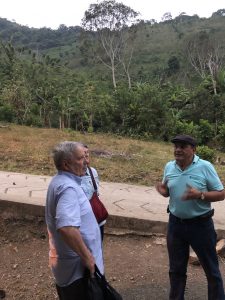The first community that our delegation met with on January 22 was in the region of Urabá, a community called Caracolón. Before going to the community, we met with Edwin Mosquera, a human rights defender in the Lutheran Church, who told us that since the Peace Process began they saw a marked reduction in the number of civilians killed (about 4,000; during the presidency of Uribe from 2002-2010 the number of civilians killed was 68,000). While he was hesitant to use statistics because “victims aren’t numbers,” it was important to note the difference in the level of killing of civilians.
He also said, though, that many feel that Colombia is entering into a new wave of violence. Seven community leaders have been assassinated just so far this year (only 7 weeks into 2019), and some are wondering if the car bombing in Bogota on January 18 is another indication of increasing violence. “We continue with hope,” he said, “but we are worried.”
One of the reasons they are worried is because land reform—one of the six pillars of the Peace Accords—will be expensive, and the new government of President Ivan Duque has not made moves to implement this part of the Accords. What’s more, Edwin emphasized, is that when the FARC held up their part of the Accords and left the lands they had been controlling, in many places other armed groups moved in, so the people who live there continue to live under a threat of violence.
And for communities like Caracolón, the possibility to return to the land from which they were displaced remains a hope more than a reality. 21 years ago, in 1997, paramilitaries came to their community, massacring 90 people and displacing another 400. Several community members met with us, and one of their leaders, a young woman named Gloria, spoke with us. They spent four years in a transitional camp before settling on the land where we visited. This land that they’re on now was provided by the government, and they have planted many crops for themselves and to sell, but it’s not enough land (only 250 acres for a whole community), and they should never have been displaced in the first place. They want to return to their land, and it’s their right to do so.

Pastor Omar tells delegates about the history of this community that was displaced 21 years ago.
The community of Caracolón is one of resistance. Shortly after being displaced, they formed a committee of memory (as well as other committees for youth and women) where they shared their experiences of the violence. They made monuments to the victims who had died in the massacre and displacement. They acknowledged that they still feel the ongling trauma of displacement, but by talking about it, they are able to take care of each other and organize to try and get their land back.
It is communities like Caracolón who have been most affected by the violence of the last six decades. It is communities like Caracolón who should be seeing the effects of the Peace Accords—they should be able to return to their land, but instead, community leader Gloria says, “We are living again with terror.” They have hope in the accords, but they are still waiting for them to be realized. And they are not waiting passively, but they continue luchando for their land, they continue taking care of each other and telling the stories.